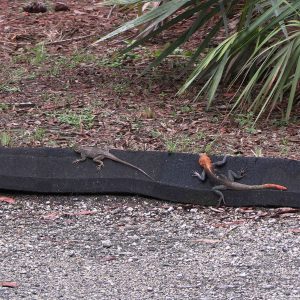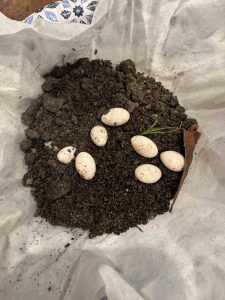
About the 4-H Agamapalooza
The UF/IFAS Extension St. Lucie County, in conjunction with the UF/IFAS Croc Docs at the UF/IFAS Fort Lauderdale Research and Education Center, is conducting the 4-H Agamapalooza Citizen Science Project in September 2024. This event is for youths ages 8-18 and will begin with an orientation on September 3, 2024 at 6:30 PM and conclude on September 30, 2024. This event is currently full with an extensive waitlist. Youth ages 8-18 will (1) increase their knowledge of invasive and nonnative reptiles such as Peters’s rock agama; (2) create their own live trap while avoiding re-release of Peters’s rock agama into the Florida environment; and (3) learn to record citizen science-related data on specimens collected.
Peters’s rock agama are nonnative reptiles introduced to the Treasure Coast via the pet trade in 1976. Since then, their population has expanded. Basic information about this species is needed for their management. This 4-H event will involve work with local youths interested in developing an effective trapping system while collecting agama biometric data for the UF Croc Docs. This will be a competitive event with the coveted Golden Lizard first prize (its a spray-painted lizard model) and certificates awarded in winning youth categories.
Process for the 4-H Agamapalooza Citizen Science Project. [UF Blog]
Common questions and answers
The purpose of this blog is to provide a list of frequently asked questions and our response.
Question: I think I found agama eggs. Will they count toward our total?
Answer: Hatch them out to verify they are actually agama. Any that successfully hatched before Sept 30th can be counted.

Question: We captured juvenile agama. How do we record that on our data sheet?
Answer: I recommend leaving the sex column blank. All juvenile agama look female. Just make a note that you collected juveniles in the “note” column.
Question:Can we trap agama at the Oxbow Eco-center in Port St. Lucie?
Answer: The Oxbow Eco-center welcomes participants but please contact Erin Cartmill or Tessa Roberts at 772-785-5833 before trapping. Oxbow environmental experts ask that you let them know when you will be on site and that live traps be monitored and observed. No live traps are to be left unattended.
Question: Can we trap at George LeStrange Preserve?
Answer: Prior permission must be obtained. Send inquiries to Ken Gioeli.
Question: If we bring you the agamas live, do you have any suggestions on the best way to take measurements? Can we take the measurements after you do the 2 step process? My boys [sic] watched a lot of videos where agamas were captured, and many escaped by fairly experienced handlers. They are soooo fast moving.
Answer: Measurements can be taken either before or after the two-step process (but before the specimens are frozen). The boys can work together to take the measurements. I can also help them with measurements when they deliver the live agama, but this is an exercise to help them “feel” what its like being field biologists. It will also slow down the check in process on Mondays and Thursdays. Sometimes field biologists have to just figure it out – especially when they’re doing wildlife surveys alone in the field. Please make sure they wear gloves partly so they can be protected against bites but also to reduce the stress on the agama they are capturing. I have measuring tape, glue traps, and small burlap sacks at the front desk at the Extension office. They are welcome to have a few.
Question: How can we best use glue traps?
Answer: Glue traps are permitted as part of our research protocols; however, the traps must be monitored on an hourly basis. You can use duct tape to affix the glue traps around the base of a tree and bait using a live cricket or two. Use vegetable oil to remove the live agama from the trap. Live trapped agama must be given fresh air and food (crickets) as needed.
Question: What is the two-step process?
Answer: The 2020 AVMA Guidelines of Euthanasia of Animals process is described on the FWC website HERE.
Question: What do we do if we don’t have cloth bags?
Answer: The UF/IFAS Extension St. Lucie County has a limited number of burlap sacks, measuring tape and other supplies available on a first come, first served basis. You can also use old pillowcases or other sacks made of cloth. If you use something like a plastic container, make sure your live agama are in separate containers and cut holes in the lid big enough for them to get fresh air but not escape. Make sure you get your agama to the Extension office on drop-off dates.
Question: Can we freeze the agama we capture in our traps?
Answer: No. FWC requires us to follow AVMA standards for humane euthanizing. You can freeze them after the two-step process results in humane euthanizing, but not before. You can also bring them to Extension live during the course of this event and we will do the two-step process. The humane way of freezing reptiles and amphibians is using liquid N but that is not typically viable for the general public. Check out page 92 of the AVMA Guideliens for Euthanasia of Animals for details.
Resources
Gioeli, K. (2024, August 19). Process for the 4-H Agamapalooza Citizen Science Project. [UF Blog] https://bit.ly/4gdE2EX
An Equal Opportunity Institution. UF/IFAS Extension, University of Florida, Institute of Food and Agricultural Sciences, Andra Johnson, Dean and Director. Single copies of UF/IFAS Extension publications (excluding 4-H and youth publications) are available free to Florida residents from county UF/IFAS Extension offices.
 1
1
